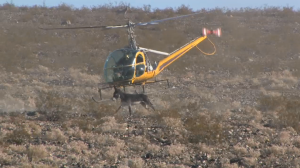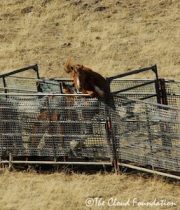The Cloud Foundation
By thecloudfoundation
You can read the full article entitled “Wild Horses and Hard Choices” from the NY Times Green Blog, published Oct. 11, 2011, here. Below is Ginger & The Cloud Foundation’s response to the factual inaccuracies the article writes about.
I have been studying and filming the natural behavior of wild horses for 17 years, and I am truly appalled at some of the glaring inaccuracies in this article. I find it shocking that the NY Times would allow something this grossly inaccurate to be posted.
The statement that wild horses are usually thin and underweight is baseless. By and large the horses on the range are in great condition, only in winter do some look thin. Those either do not make the winter, which is a part of natural selection, or bounce back come spring. As evidence, take a look at the volumes of footage of horses in the past several years running in the traps. Just where are the thin and, according to BLM propaganda, starving wild horses?
You say BLM is planning a removal of 6,000 horses but fail to mention this is for only half of FY2012—until the first of March. The new schedule does not include the summer and early fall removals to be conducted. While helicopters are supposed to be a tool for roundups, they have in the past two years been used as weapons. There is absolutely no excuse for hitting horses or knocking down burros with the skids of the choppers. Once a BLM management policy that allowed for the removal of only adoptable aged animals five and under has been expanded to animals of all ages—a scorched earth policy that includes running and capturing old animals only months or a few years from dying a natural death in the land in which they were born. Any rounded up which don’t meet a perfection standard in BLM’s eyes are shot or euthanized.
I have never seen a wild horse contaminate its water resource. Cattle, on the other hand often ruminate chew for hours near water and defecate regularly in their water sources, trampling sensitive riparian areas in the process. Wild horses may linger for a while at water but usually move off quickly, traveling to their preferred grazing on higher, dryer ground, regularly traveling 5-10 miles in a day, sometimes even farther.
BLM maintains there are 38,500 wild horses and burros on the range—a statistical impossibility using BLM’s own reported numbers from 2007 to the present. Subtracting removals and even adding their inflated reproduction rates of 20% yield less than 18,000 wild horses and burros remaining in the wild.
There is also inaccurate information regarding the current number of wild horse herds remaining. While there were over 339 herd areas originally established, that number has shrunk to less than 180 herd management areas. Based on current management tactics, it is clear BLM is managing wild horses and burros to extinction.
BLM does not own the long-term holding pastures where older or “unadoptable” horses go to, which your article maintains. On the contrary, these areas are privately owned and the owners receive $500 per horse a year to take care of them. Short-term holding costs are even more expensive, with costs of around $5.50 per day for each horse that spends its days and nights feedlot facilities.
Last year only approximately 1,500 horses were adopted out. Sick or injured horses are immediately euthanized and usually will never make it to the short-term holding facility. For example, a horse who was blind in one eye and healthy was immediately shot after he was rounded, the reason given that he would not do well in holding. Sadly he is one of hundreds killed by BLM because they have an imperfection that does not impair their ability to live a life of freedom on their legally designated homelands.
The wild horse evolved in North America, only dying out after it completed its evolutionary path. The horses that died out some 7,000 years ago—not the 10,000 claimed by the author, returned with the Spanish in the early 1500s to repopulate ecosystems in which they evolved over the millennia. Check the new science and remarkable new discoveries made just since the mid-90s on this topic.
The wild horse is a returned native and should be accorded the status they deserve. Sadly, that would be an endangered species listing. Less than 2% remain from millions that roamed the continent just a little over 100 years ago.
I would think it an embarrassment to a well-respected publication like the NY Times to learn it had misled the public (albeit unintentionally), with this article. The story of wild horses on public lands is a far different one than this biased, one-sided on line piece would lead one to believe.
Sincerely,
Ginger Kathrens




No comments:
Post a Comment